RESTORING A MORGAN - page
three
by Lorne Goldman
5. The refurbishing of the retained componentry continues
(front suspension next!), replacements are sourced for items too worn,
unrefurbishable and simply unwanted.
6. December 19th, 2006. It's a good day! Something I had
been very concerned about, a full chassis examination, happened early this
morning in Market Drayton.
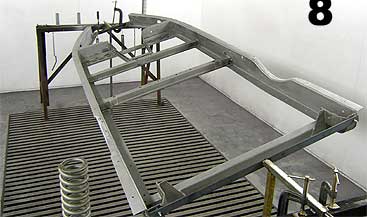 The
flexing Morgan chassis (aka frames) are wear parts. Though they will normally
last 20+ years, this is not a rule, and they CAN last less. Our UK Mog
comes from an era which is post-cuprinol, so I did not worry on the wood,
but it is from the era of pre-galvanizing frames and had never been heavily
undercoated (one of the reasons I bought it).
The
flexing Morgan chassis (aka frames) are wear parts. Though they will normally
last 20+ years, this is not a rule, and they CAN last less. Our UK Mog
comes from an era which is post-cuprinol, so I did not worry on the wood,
but it is from the era of pre-galvanizing frames and had never been heavily
undercoated (one of the reasons I bought it).
It has been gone over with a fine tooth-comb and it is
solid as Gibraltar!
The frame is shot-blasted, sanded smoth and flat,
primed, sealed and painted.
N.B. Sheet steel panels are sand blasted only
if they are very rusty, BUT you have to have find somebody who is really
good and have a lot of faith in them, as the heat generated during blasting
can easily destroy the panels. DO NOT DO IT UNLESS YOU REALLY TRUST THE
OPERATOR!!
6. All mild steel parts are inspected as they are stripped
and then immediately primed. The priming is necessary even if they are
to be modified or repaired as air quickly rusts absolutely bare steel within
hours ...especially in England.
8. The wings,
cowl and bonnet have returned from the stripper. The closeup look at the
stripped parts show a sad story. There are far from perfect. There are holes
at the wing lamps. Not uncommonly, the stress at this point has been too
much for the wing. However, a real expert can fix this as good as new by
welding in fresh metal aluminum. See picture. A section is cut out
and replaced, then ground and sanded to leave the repair imperceptible.
The damage goes further though. The pre-Superform alloy
wings (1960s to 1998) were/are made by a company called Vintage Wing and
Radiator. These are made by metal beating and use an alloy soft enough
to be susceptible to this. To stiffen the edge of the wings, a steel wire
was used and the edge rolled around it. Over time, there is a hostile electrolytic
reaction between the two metals and edge of wings rot. If it is caught
in time, the edge can be "unrolled", the wire removed, the cavity cleaned
out thoroughly and the wire replaced with non-reactive compounds that will
prevent the two metals from reacting with each other.
This is where only the best of experts can advise you.
Kevin considers the wings for a day or two and regretfully reports that
he cannot absolutely guarantee that a repair will last more than 2-5 years
in British weather. That counsel, from that source, is enough for me. I
am looking for a "forever" car and though a future wing replacement is
nowhere as onerous a task as restoration. I make a decision to consider
other options.
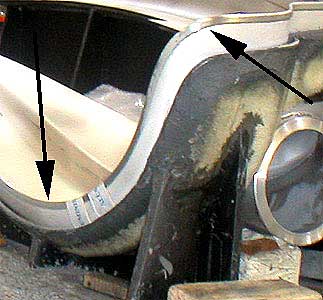 Vintage Wing & Radiator still supply the older Morgan wings through
the MCC and to the market directly in both alloy and steel. (Steel wings
may rust
Vintage Wing & Radiator still supply the older Morgan wings through
the MCC and to the market directly in both alloy and steel. (Steel wings
may rust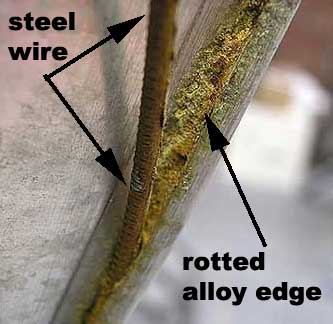 but there are always repairable as they will not rot in the same
way the Vintage alloy wings will.). The wait is three weeks. However,
the Vintage wings are made as they always were. As they are beaten to shape.
This means that much filler and preparation time will be necessary to make
them smooth and consistent. As well, they still use the steel stiffening
wire on a roll edge and will not change even on request. A few years will
create the same problem unless we open up the edge and treat the wire in
hope of slowing the inevitable process. Lastly, the soft Vintage
alloy wings are susceptible to road damage and star fractures.
but there are always repairable as they will not rot in the same
way the Vintage alloy wings will.). The wait is three weeks. However,
the Vintage wings are made as they always were. As they are beaten to shape.
This means that much filler and preparation time will be necessary to make
them smooth and consistent. As well, they still use the steel stiffening
wire on a roll edge and will not change even on request. A few years will
create the same problem unless we open up the edge and treat the wire in
hope of slowing the inevitable process. Lastly, the soft Vintage
alloy wings are susceptible to road damage and star fractures.
Superform
wings are formed by suctioning heat-softened alloy sheets onto a Morgan
wing mold. This makes their consistency and surface finish near perfect.
As it is heat not hammering that forms the wing, the alloy used is far
harder than that used by Vintage Wing & Rad and the Superforms are
far more damage and stone resistant than the earlier wings. The edge is
not rolled but rather formed by a molding which is epoxied on. (In the
earlier Superform days, this epoxy and MMC paint process could cause a
reaction appearing as bubbling around the edge.)
The
MMC charged far more for Superform wings Vintage Wing &
Radiator wings
but that difference is made up in a saving on restorer preparation
time and cost. They are better, bit lighter product. However,
though Superform
were wings regularly supplied to the Factory, (they no use a
different process as Superform is much less in business than it once
was) but Plus 8 wings (front) have
gone the way of the Plus 8 and are stocked now only when ordered. I
recommend the new VW&R.
N.B. It was noted by many that the rot
with many of the older Vintage Wing & Rad wings can likely be cured by cutting
out the rolled edge and steel wire and using a Superform wing moulding
to refinish the edge. This would save 100s of Morgan wings. However, we
were informed by the MMC that they will not supply them (or
anyone else) this molding by itself. New wings must be purchased.
In sum, I no longer believe that earlier alloy winged
Morgans should merit a premium in the buying price over steel. Steel wings
last longer, are considerably more impact resistant and can always be repaired
if they rust. Early alloy wings come with their rot pre-determined and
impossible to repair, are very suceptible to impact leading to paint stars
and cracks.
Page four
 The
flexing Morgan chassis (aka frames) are wear parts. Though they will normally
last 20+ years, this is not a rule, and they CAN last less. Our UK Mog
comes from an era which is post-cuprinol, so I did not worry on the wood,
but it is from the era of pre-galvanizing frames and had never been heavily
undercoated (one of the reasons I bought it).
The
flexing Morgan chassis (aka frames) are wear parts. Though they will normally
last 20+ years, this is not a rule, and they CAN last less. Our UK Mog
comes from an era which is post-cuprinol, so I did not worry on the wood,
but it is from the era of pre-galvanizing frames and had never been heavily
undercoated (one of the reasons I bought it).
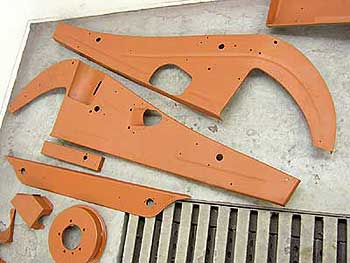
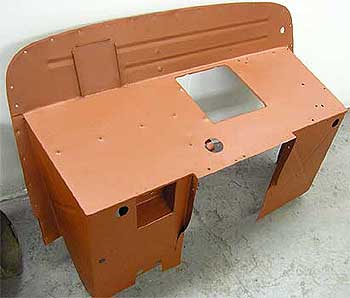
 Vintage Wing & Radiator still supply the older Morgan wings through
the MCC and to the market directly in both alloy and steel. (Steel wings
may rust
Vintage Wing & Radiator still supply the older Morgan wings through
the MCC and to the market directly in both alloy and steel. (Steel wings
may rust but there are always repairable as they will not rot in the same
way the Vintage alloy wings will.). The wait is three weeks. However,
the Vintage wings are made as they always were. As they are beaten to shape.
This means that much filler and preparation time will be necessary to make
them smooth and consistent. As well, they still use the steel stiffening
wire on a roll edge and will not change even on request. A few years will
create the same problem unless we open up the edge and treat the wire in
hope of slowing the inevitable process. Lastly, the soft Vintage
alloy wings are susceptible to road damage and star fractures.
but there are always repairable as they will not rot in the same
way the Vintage alloy wings will.). The wait is three weeks. However,
the Vintage wings are made as they always were. As they are beaten to shape.
This means that much filler and preparation time will be necessary to make
them smooth and consistent. As well, they still use the steel stiffening
wire on a roll edge and will not change even on request. A few years will
create the same problem unless we open up the edge and treat the wire in
hope of slowing the inevitable process. Lastly, the soft Vintage
alloy wings are susceptible to road damage and star fractures.